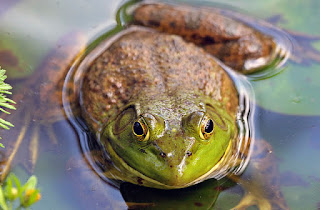When you live on a lake you find yourself telling the seasons and
predicting weather in more natural ways.
The house faced the lake (SSE), so when the wind began blowing off the
lake toward the house, we knew bad weather was on its way, no matter what the weather station or the meteorologists said. When the wind shifted a change was coming; and when it finally blew
from the back yard down the lake, we knew the weather was guaranteed fair.
Somehow wind direction is always clearer when you can see it
moving on the water.
Recognizing a change in seasons became easy once we learned to read several indicators. Frog song changed across spring into summer. While it began with tiny high-pitched frenetic sound, it eventually deepened to big belching “jug o’ rum” calls by mid-August: a song that was guaranteed
to drive away sleep, since bullfrogs have absolutely NO sense of rhythm. But the best indicator of the advent of winter
and spring were ducks.
Normal lake life in Washington state is populated by your
basic mallard, the home team duck, who lives here year-round and announces spring by producing loads
of babies. Baby ducks are
fodder for everything else in the animal kingdom; locally common predators
include bass, eagles, osprey, and anything hungry enough to think that a two-ounce
ball of fluff makes a good snack. When you
see ducklings daily, though, you
also recognize who is a good mama duck, and who is shell-shocked (pun intended)
over having little ones trailing around behind them. The babies whose mama
watches their every paddle will have a higher survival rate by far; but the babies who are little alpha wanderers, paddling off to see the world with no regard
for where mama is, will be the first to be culled from the flock.
 |
| Mallard ducklings with good mama. |
The ducks that migrate through are the ones that tell
you when winter has arrived and when it finally leaves. Washington state is on a flyway for hundreds
of bird species that migrate between Alaska and Mexico, but we knew to watch
for buffleheads.
Buffleheads are the
clowns of the duck world, the smallest diving duck in North America, and they
spend their summers in the Arctic. When
it gets a little chilly there, they migrate south to Washington, where their
appearance is the sure sign that winter has arrived. And as long as they lounge around, winter
still haunts the lake. Spring may flirt with you, but it never comes to stay until the last bufflehead wings north for a summer stay in the balmy arctic.
The best time comes when the lake first begins to thaw, because the top water melts first. Underneath maybe an inch of free water, the ice lingers and the ducks walk…on water. Or, they land with great confusion careening across the ice with complete lack of control. Duck on Icy Landing Approach













Ruth, I love the Lakeside Living series you are writing. Knowing it is a personal journey makes it that much more special. Thank you for sharing with us.
ReplyDelete